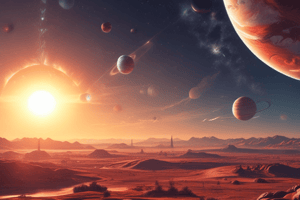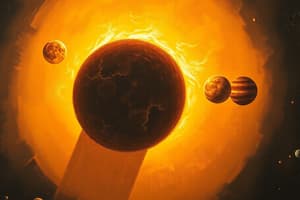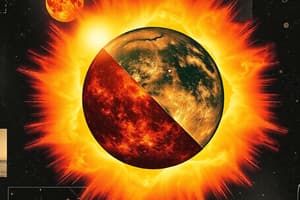Podcast
Questions and Answers
Which of the following planets are classified as gas giants?
Which of the following planets are classified as gas giants?
- Jupiter (correct)
- Venus
- Mercury
- Mars
All outer planets in our solar system are gas giants.
All outer planets in our solar system are gas giants.
False (B)
What is the prevailing theory that describes the origin of the universe?
What is the prevailing theory that describes the origin of the universe?
Big Bang Theory
The equation for photosynthesis is ___ + ___ → ___ + ___.
The equation for photosynthesis is ___ + ___ → ___ + ___.
Match the following parts of the Sun with their descriptions:
Match the following parts of the Sun with their descriptions:
What are some of the uses of artificial satellites?
What are some of the uses of artificial satellites?
How can a person reduce their carbon footprint?
How can a person reduce their carbon footprint?
The cycling of nitrogen involves activities that are entirely biotic.
The cycling of nitrogen involves activities that are entirely biotic.
What is the primary cause of ecosystem sustainability loss?
What is the primary cause of ecosystem sustainability loss?
Greater biodiversity leads to greater stability in ecosystems.
Greater biodiversity leads to greater stability in ecosystems.
What are two key processes that are complementary in the cycling of carbon?
What are two key processes that are complementary in the cycling of carbon?
The process where water vapor condenses to form droplets is called ______.
The process where water vapor condenses to form droplets is called ______.
Match the following terms to their definitions:
Match the following terms to their definitions:
Which of the following best describes cellular respiration?
Which of the following best describes cellular respiration?
Agroecosystems have higher biodiversity compared to natural ecosystems.
Agroecosystems have higher biodiversity compared to natural ecosystems.
Explain the process of eutrophication.
Explain the process of eutrophication.
The total amount of greenhouse gases emitted by an individual's activities is known as their ______.
The total amount of greenhouse gases emitted by an individual's activities is known as their ______.
How does deforestation affect the water cycle?
How does deforestation affect the water cycle?
Flashcards
Biodiversity
Biodiversity
The variety of life in a particular ecosystem.
Species Richness
Species Richness
The number of species in an area.
Monoculture
Monoculture
Cultivation of a single crop in an area.
Cellular Respiration
Cellular Respiration
Signup and view all the flashcards
Photosynthesis
Photosynthesis
Signup and view all the flashcards
Carbon Footprint
Carbon Footprint
Signup and view all the flashcards
Nitrogen Cycling
Nitrogen Cycling
Signup and view all the flashcards
Primary Succession
Primary Succession
Signup and view all the flashcards
Secondary Succession
Secondary Succession
Signup and view all the flashcards
Eutrophication
Eutrophication
Signup and view all the flashcards
What are terrestrial planets?
What are terrestrial planets?
Signup and view all the flashcards
What are gas giants?
What are gas giants?
Signup and view all the flashcards
What is the Big Bang Theory?
What is the Big Bang Theory?
Signup and view all the flashcards
What are artificial satellites used for?
What are artificial satellites used for?
Signup and view all the flashcards
What is sustainability?
What is sustainability?
Signup and view all the flashcards
What are the Earth's spheres?
What are the Earth's spheres?
Signup and view all the flashcards
What is the equation for photosynthesis?
What is the equation for photosynthesis?
Signup and view all the flashcards
What is the equation for cellular respiration?
What is the equation for cellular respiration?
Signup and view all the flashcards
Study Notes
Solar System Planets
- Our solar system has 8 planets: 4 inner planets (Mercury, Venus, Earth, Mars) and 4 outer planets (Jupiter, Saturn, Uranus, Neptune).
- Inner planets are terrestrial (rocky) with few or no moons.
- Outer planets are either gas giants (Jupiter, Saturn) or ice giants (Uranus, Neptune). Gas giants have many moons and rings. Ice giants also have moons and (sometimes visible) rings.
Sun's Structure and Activity
- Sun's Interior:
- Core: Central region
- Radiative zone: Energy transfer via radiation
- Convective zone: Energy transfer via convection
- Sun's Surface and Atmosphere:
- Photosphere: Visible surface
- Chromosphere: Sun's atmosphere
- Corona: Outermost atmosphere
- Sun Features:
- Sunspots: Cooler areas on the photosphere
- Solar flares: Sudden bursts of energy
- Solar prominences: Streams of glowing gas
Big Bang Theory
- The Big Bang Theory explains the universe's origin.
- About 14 billion years ago, the universe began as a giant explosion.
- This expansion and cooling led to the formation of matter, stars, and galaxies.
Artificial Satellites
- Artificial satellites are used for various applications:
- Weather forecasting
- Navigation (e.g., GPS)
- Exploring the universe
Sustainability and Human Impact
- Human activities significantly affect ecosystem sustainability.
- These activities alter both biotic and abiotic factors of ecosystems.
- Examples of human activities that change sustainability: Species diversity loss, Agriculture, Deforestation, Fossil fuel usage.
- Biodiversity is variety of life in an ecosystem, high biodiversity means greater stability.
Photosynthesis and Cellular Respiration
- Photosynthesis:
- Producers (like plants) use light energy to convert carbon dioxide and water into glucose (sugar) and oxygen.
- Occurs in chloroplasts
- Cellular Respiration:
- Consumers use oxygen and glucose stored in food to release energy.
- Produces carbon dioxide and water as waste products.
- Occurs in mitochondria
- Both processes are complementary: The reactants of one are the products of the other.
Carbon Footprint
- A carbon footprint is the total greenhouse gases emitted from human activities.
- Increased carbon dioxide leads to global warming, climate change, ocean acidification, and sea-level rise.
Water Cycle
- The water cycle involves evaporation, condensation, precipitation, and runoff.
- Plants also contribute to the cycle through transpiration.
Water Cycle and Human Activities
- Irrigation, hydroelectricity, deforestation, and fossil fuels alter the water cycle in different ways.
- Irrigation removes water from natural sources, changing evaporation and rainfall patterns.
- Dams for hydroelectricity alter river function and water levels.
- Deforestation reduces transpiration, potentially lowering water levels in the atmosphere
- Fossil fuels impact the water cycle through climate change, increasing evaporation and ice melt.
Studying That Suits You
Use AI to generate personalized quizzes and flashcards to suit your learning preferences.




